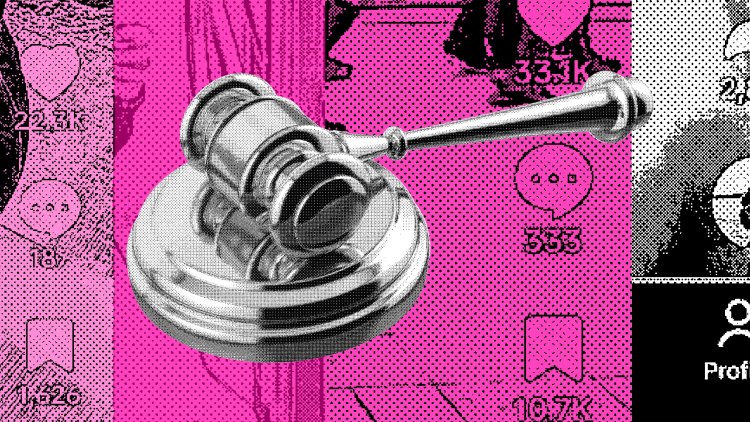What If Free Speech Means Banning TikTok?
A federal court is floating a new framework for thinking about the First Amendment in the age of social media.

Many will read last week’s federal appeals-court opinion that could ban TikTok as a loss for the First Amendment, and in some ways it is. If TikTok disappears from the United States, some 170 million Americans will lose access to a platform central to their daily lives and creative expression. And the court’s deference to Congress and the executive branch’s national-security claims continues a pattern of courts weakening First Amendment protections whenever the government invokes national-security concerns.
But the opinion need not be viewed solely through this lens. Significantly, the court rejected the usual framing of national security versus the First Amendment, and instead cast TikTok itself as the First Amendment villain. This approach could have long-term consequences for the government’s ability to regulate the internet.
Historically, when courts have considered cases involving national security and free speech, they’ve treated them as a zero-sum game: either protect national security at the expense of First Amendment rights, or preserve First Amendment freedoms despite potential security risks. Legal observers (myself included) expected the case to follow this familiar pattern, with the court weighing TikTok’s free-speech claims against the government’s national-security concerns about data privacy and information manipulation.
[Read: America lost the plot with TikTok]
But in its decision, the court did something unexpected. In addition to crediting the government’s national-security arguments, it highlighted an important tension within pro-free-expression arguments: the right to access and speak on the platform of one’s choosing versus the right to have platforms free from foreign manipulation and control. The court explained:
In this case, a foreign government threatens to distort free speech on an important medium of communication. Using its hybrid commercial strategy, the [People’s Republic of China] has positioned itself to manipulate public discourse on TikTok in order to serve its own ends. The PRC’s ability to do so is at odds with free speech fundamentals. Here the Congress, as the Executive proposed, acted to end the PRC’s ability to control TikTok. Understood in that way, the Act actually vindicates the values that undergird the First Amendment.
This anti-distortion rationale for government speech regulation used to be central to the First Amendment, especially in campaign-finance cases, until the Supreme Court rejected it when striking down corporate campaign-contribution limits in Citizens United v. FEC. Recently, in last term’s Moody v. NetChoice, the Court criticized state laws limiting social-media content moderation by invoking an (in)famous 1970s precedent that the government cannot “restrict the speech of some elements of our society in order to enhance the relative voice of others.”
But the anti-distortion rationale lives on in national-security cases. For example, only a year after Citizens United, the Supreme Court affirmed a decision by then–D.C. Circuit Court Judge Brett Kavanaugh that foreigners have no First Amendment right to contribute to U.S. elections.
The anti-distortion argument also figured in the concurring opinion by Sri Srinivasan, the chief judge of the D.C. Circuit, which focused on the long history of legislation restricting foreign ownership of key sectors of the U.S. economy, including radio, broadcast TV, and cellular networks. These restrictions were motivated by the same legitimate concerns as the TikTok law: the possibility for covert manipulation of the American information environment. The emphasis here is on covert because, as Srinivasan pointed out, “counterspeech”—responding to objectionable speech with more speech—“is elusive in response to covert (and thus presumably undetected) manipulation of a social media platform.”
TikTok has few good options; the law prohibits app stores and cloud-service providers from hosting TikTok and its app unless ByteDance, its Chinese parent company, divests, which it is unlikely to do. Donald Trump campaigned against the law (despite trying to ban TikTok during his first administration), but he has backed away from his promises to save TikTok. Even if he wants to help the beleaguered company in his second term, his options are limited, because the key players are private companies, such as Apple and Oracle, that would face penalties for providing services to TikTok.
[From the November 2021 issue: The largest autocracy on Earth]
This leaves the Supreme Court, to which TikTok plans to appeal the D.C. Circuit’s decision. Although the justices aren’t required to hear the case, they may be inclined to, given the high legal and policy stakes. They will also probably pause the law while they deliberate, giving TikTok a reprieve until the Court’s decision this summer. But TikTok may not find that the Court is any more receptive to its cause than the cross-ideological panel of judges at the D.C. Circuit.
Thus, as soon as this summer, TikTok as we know it may not be America’s leading short-form video platform anymore. The longer-term effects of the litigation are less clear. If the Supreme Court embraces the D.C. Circuit’s reasoning that banning TikTok complies with and indeed advances First Amendment principles—especially if it extends this reasoning beyond the national-security context—it could open the door to more assertive government regulation that curtails some speech rights in favor of safeguarding the First Amendment more broadly. Although this would, in certain ways, vindicate a long-standing goal of liberals and progressives to address the flaws of unregulated speech environments, it matters greatly who in the government wields that power—and with the incoming Trump administration, the implications could be unsettling.
What's Your Reaction?




















